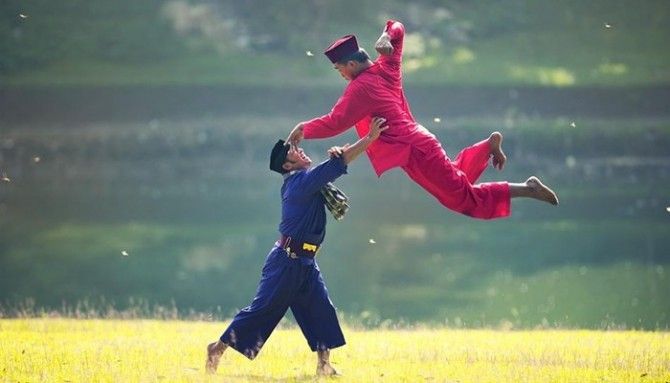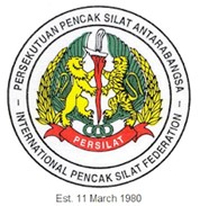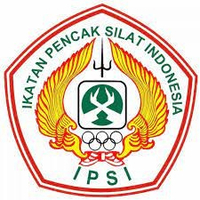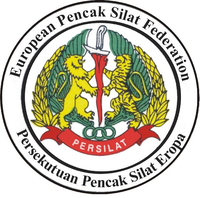
Pencak Silat (Brunei Darssalam, Indonesia)
- Name of sport (game): Pencak Silat
- Name in native language: Silek, Mancak, Ulu Ambek/Alau Ambek, Sewah, Galuik (West Sumatera); Bepencak (Bangka); Pencé (Banten); Silat (West Java, Special Capitol Region of Jakarta, Banten, Central Java, East Java, Special Region of Yogyakarta, Bali); Penca, Amengan, Ulinan, Maénpo, Usik, Heureuy (West Java); Maen Pukulan (Special Capitol Region of Jakarta); Akeket, Okol, Penthengan (Madura, East Java); Encak, Pencakan (East Java); Pencak (Special Region of Yogyakarta, East Java, Bali); Kuntau (West Kalimantan, Central Kalimantan, South Kalimantan, East Kalimantan); Langga (Gorontalo), Amanca (South Sulawesi); Pakuttau (West Sulawesi), Mencak, Kuntuh (West Nusa Tenggara).
- Place of practice (continent, state, nation):
Research has indicated that the initial growth of Pencak Silat originated from the West Sumatera and West Java regions. Up to this day, Pencak Silat has grown to spread all across Indonesia, especially in the provinces of West Sumatera, Bangka, Banten, West Java, Special Capitol Region of Jakarta, Central Java, Special Region of Yogyakarta, East Java, Bali, West Kalimantan, Central Kalimantan, South Kalimantan, East Kalimantan, Gorontalo, South Sulawesi, West Sulawesi, and West Nusa Tenggara. In its spread, every region has assimilated the Pencak Silat traditions with their local culture, such as types of accompaniment music along with the musical instruments, types of costumes, forms of oral traditions and expressions, types of weapons, etc., without removing the core values of Pencak Silat teachings. Pencak Silat schools have now been established in 34 provinces in Indonesia and have spread to 52 countries.
- History:
As a country that surrounded by forests and various kinds of wild animals, the ancestors of Indonesia were accustomed to protecting themselves from both human and nature. In fact, thanks to nature, the ancestors of Indonesia able to learn few fighting moves.
By taking example of wild animals move, such as monkey, tiger, snake, hawk and many more, Pencak Silat as we know today is born. There is also another assumption that Pencak Silat came from the great skills of Indonesian native tribes in hunting and war. Cina and India are also bring influence of martial arts to Pencak Silat.
Pencak Silat is believed to start spreading around the 7th century AD but no one know for sure. It was assumed that Pencak Silat spread from Sumatra to various regions of Southeast Asia seacoast.
The spreading of Silat itself is just like any other kind of education. It was passed down from a teacher to a student. Although, at the very first time, it’s only simply from mouth to mouth.
The famous ancient kingdom of Indonesia such as the Kingdom of Sriwijaya and the Kingdom of Majapahit are told to have their own powerful warriors. These warriors have a very great skill in using the movement of martial arts.
Silat is more known as gayong and cekak Malaysia and Singapura. In Thailand, silat is known as bersilat, meanwhile it is known as pasilat in the southern Philippines.
Almost every region have their own martial arts character or warrior that they proud of. From Sunda Pajajaran, there is Prabu Siliwangi, as well as, Hang Tuah, the commander from Malacca. Gajah Mada, the Mahapatih from Majapahit kingdom and Si Pitung from Betawi are also the most well-known martial arts warrior in the history and legend. In the 11th century, there is a legend of Minangkabau, a practiced Silat, which in Minangkabau language called Silek, by Datuk Suri Diraja of Pariangan, Tanah Datar, which later being developed by the Minang people throughout Southeast Asia.
In the 14th century, the propagators of Islam contributed in spreading Silat across the country by teaching Silat along with the religion subject in surau or pesantren. Silat has become a part of the daily spiritual practice. - Description:
Although better known worldwide as a type of martial arts, Pencak Silat is actually an Indonesian tradition that has been transmitted over many generations. In addition to its sporting aspect, the Pencak Silat tradition also encompasses the aspects of mental-spiritual, self-defense, and art. The term Pencak Silat is formed from two words, which are pencak and silat. The term "pencak" is better known in Java, while the term "silat" or "silek" is better known in West Sumatera, to describe a group of martial arts which have many similarities. In addition to using local terms, each region has their own move, style, accompaniment music, and unique supporting equipment. The moves and styles in Pencak Silat are strongly influenced by various elements of art. These moves and styles are a unity of body movement (wiraga), movement feeling (wirasa), and movement fit to the accompaniment music (wirama). The supporting equipment for Pencak Silat includes costumes, music instruments, and traditional weapons.
Pencak Silat practitioners are taught to maintain their relationship with God, human beings, and nature. These practitioners are also trained in various techniques to deal with attacks or other dangerous situations based on principles to protect him or herself as well as others, avoid harming the offender, and build comradeships. Pencak Silat is often performed during various ritual ceremonies and celebrations. Men and women of all ages, as well as the disabled, can all practice Pencak Silat. They usually will learn in Pencak Silat schools or academic schools from kindergarten to college.
The bearers and practitioners of Pencak Silat consist of:
a. Elders (Sesepuh/Tuo Silek/Pinisepuh/Rama), which are senior and respected individuals that nurture the Pencak Silat community.
b. Grand Masters (Guru Besar/Guru Gadang/Pandeka/Maha Guru), which are school founders or their successors with the highest rank in knowledge that are responsible for the growth and safeguarding of Pencak Silat at the school.
c. Masters (Guru/Guru Tuo), which are individuals that teach and guide disciples, both physically and mental-spiritually. The Master is responsible for perfecting the forms of styles and techniques (style application), as well as instill character into the disciples.
d. Coaches (Pelatih/Palampeh), which are individuals that have mastered the forms of styles and techniques directly related to the forms of styles and techniques taught to the disciples. The Coach is responsible for training and guiding disciples, as well as evaluating the progress of disciples. In addition to training disciples, the Coach will also train with the Master or Grand Master.
e. Disciples (Murid/Anak Sasian/Putra/Siswa), which are individuals that learn at the school and are responsible for obeying the school oath, maintaining discipline in training, and upholding the reputation of the school. Every level completed by the disciple will be evaluated by a Coach or a Master to determine eligibility for progression in ranks.
For certain schools which have particular customs that regulate interaction between males and females, the role of a female coach becomes important to ensure teachings and guidance for female disciples.Pencak Silat is commonly taught through non-formal education in Pencak Silat schools using methods and traits of transmission that are accustomed to each school. Pencak Silat is also taught through extracurricular activities or local content in schools starting from kindergarten to college. Methods used in teaching are adjusted to fit the age group.
Transmission methods of Pencak Silat knowledge and skills to disciples vary according to the customs and traditions of the Pencak Silat school. Knowledge and skills transmitted include the unique oral traditions and expressions of each school, such as greetings, philosophical phrases, rhymed poems, advice, etc., as well as the practice of performing accompaniments, such as list of songs and techniques to play the instruments. Skills particularly related to style and technique are taught to the disciples by example. Several schools also teach disciples on how to adjust styles and techniques according to the accompaniment.
Knowledge of Pencak Silat values and meanings are shared by coaches or masters. The mental-spiritual education process starts immediately once the disciple is accepted to the school. Education on the values and meanings of Pencak Silat styles and techniques are taught throughout practice sessions, from beginning to end.
As for the creation of costumes, accompaniment instruments, and traditional weapons, the required knowledge and skills have not yet been specifically transmitted by the Pencak Silat community. Especially for accompaniment instruments and traditional weapons, this is because most of these equipment are also used in other forms of arts.There are few terms applied in Pencak Silat, such as:
• Kuda-kuda is a term for the position of the foot tread to strengthen the position of the body.
• Sikap and Gerak is a term for certain movements that performed in a match.
• Langkah is a terms for the use of steps in silat, such as Langkah Tiga and Langkah Empat.
• Kembangan is a term for the hand movements and body gestures performed while paying attention and aware of the movements of the enemy, as well as lurking for a gap between the enemy’s defenses.
• Buah is a term for the defense and attack techniques in silat.
• Jurus is a term for a series of basic movements for the upper and lower body, which is used as a guide to master the use of advanced techniques of martial arts (buah)
• Sapuan and Guntingan is a term for one type of buah (technique) to dropped an enemy by attacking the enemy’s kuda-kuda, which kicking it off with a swipe (cut), so that the enemy lose his or her balance and fall.
• Kuncian is a term for techniques to knock out an opponent until he or she become helpless, unable to move, or to disarm the enemy. Like a locking snake do to its food.There are few weapons use in Pencak Silat, such as:
• Keris: a dagger with spired and sharp on both sides.
• Kujang: a specific knife of Sundanese.
• Samping/Linso: a silk scarf worn around the waist or shoulder in order to protect one from knife attack and to do Kuncian.
• Galah: sticks made of wood, steel or bamboo.
• Cindai: a fabric which is usually used as a glove or wrapped as head gear.
• Tongkat/Toya: a stick used by elders, travelers and musafir.
• Kipas: a traditional folding fan which can be made of wood or iron.
• Kerambit/Kuku Machan: a blade shaped like tiger claws that can betucked in women’s hair.
• Sabit/Clurit: a sickle used in agriculture, cultivating and harvesting crops.
• Sundang: a double edge sword of Bugis.
• Rencong: a slightly curved dagger from Aceh.
• Tumbuk Lada: literally meaning “peppercorn crusher”, a small dagger that is slightly curved like Rencong.
• Gada: a dull weapon made of steel.
• Tombak: a javelin made of bamboo, steel or wood.
• Parang/Golok: short sword used to cut branches that get in the way when passing through the woods.
• Trisula: a three stake or a three-pronged weapon.
• Chabang/Cabang: a short-handled trident. - Current status:
Pencak Silat will continue to strive, as many of its communities have conducted various safeguarding activities. For example, Paseduluran Angkringan Silat (PAS) in the Special Region of Yogyakarta has continuously put in efforts to showcase the cultural side of Pencak Silat in various events. In 2015, this community held the National Pencak Silat Jamboree, which hosted more than 6,000 practitioners from 42 schools across Indonesia. Currently, PAS is cooperating with Sanggar Silat Satria Tama to create Pencak Silat tourism, where various Pencak Silat choreographies will be performed as part of its main attraction.
In East Java, there is a festival held to strengthen comradeship among schools called Festival Pencak Arisan. Meanwhile in West Java, there are several Pencak Silat festivals, including Festival Rampak Pencak Silat Jawa Barat, which in 2014 managed to enter the list of national records as it successfully gathered more than 10,000 practitioners from various schools in West Java. Another example would be the many Pencak Silat festivals in West Sumatera, including Festival Silat Tradisi, which in 2016 managed to gather more than 1,000 practitioners from 10 different countries. In Banten, the Golok Day Festival also managed to gather more than 1,000 practitioners.
In addition to festivals, communities have performed various identification, documentation, and research activities related to Pencak Silat, including efforts of preservation and protection. An example would be the efforts made by PAS to document various schools in audio-visual form and make them available for access through the internet
The Government has given attention towards the safeguarding and continual growth of Pencak Silat. In its efforts to safeguard Pencak Silat, the Government has faced several constraints, mostly due to limited financial and human resources. Regardless, over the years, it has continually performed inventory and documentation efforts in several regions across Indonesia, while officially recognizing Pencak Silat as an Intangible Cultural Heritage of Indonesia. Facilitation for various events has been given to many schools in the form of costumes, musical instruments, mattresses, etc.
Pencak Silat schools are also supported by the Government via the national Pencak Silat organization, Ikatan Pencak Silat Indonesia (IPSI). For example, through its branch in West Sumatera, in coordination with the local government, a special festival called Festival Gelanggang Silih Ganti is annually held to showcase Pencak Silat attractions that use costumes and accompaniment that are unique from each region. A similar effort has been done in West Java with the Pasanggiri Pencak Silat, which in 2017 is planned to be attended by practitioners from various countries.
The Government has also honored and nationally recognized Mr. Eddie M. Nalapraya as a Pencak Silat Elder, as well as several other practitioners as Pencak Silat masters. Currently, the Government is developing a policy that is aimed to strengthen support for academic schools of all levels to include Pencak Silat in their local content.
- Importance (for practitioners, communities etc.):
The social function of Pencak Silat is to strengthen comradeship among school members and among schools, maintain social order, and provide entertainment for ritual ceremonies. Another function is its use in healing muscle and bone problems.
In its function to strengthen comradeship while providing entertainment for ritual ceremonies, the role of Pencak Silat is showcased in the ceremonies of Jagongan Pencak in the Special Region of Yogyakarta and Central Java, and Manten Pegon in East Java. In its function to maintain social order, the role of Pencak Silat is portrayed in the Parik Pagar Nagari tradition, where the Pencak Silat expertise is used to protect the village.
The cultural meanings of Pencak Silat, which closely relates to the personal identity of each school and each of its members, varies among communities. The choice of accompaniment, including musical instruments, type of music, story, etc., as well as choice of costumes is essential in developing the aforementioned personal identity.
Cultural meanings are also conveyed in the oral traditions and expressions of each school. Most phrases taught in schools convey morale messages in the local language based on their values. Certain ritual ceremonies present a series of cultural meanings, such as the Palang Pintu ceremony in the Betawi culture, where men have to fight for their love, protect their family, adapt to the family of their spouse, while showing their capability in providing for their family. Similar ceremonies like Parebut Seeng and Begalan can be found in West Java and Central Java, respectively.All parts of the Pencak Silat tradition are compatible with existing international human rights instruments, the requirement of mutual respect among communities, groups, and individuals, as well as sustainable development. In fact, Pencak Silat highly honours the spirit of mutual respect among communities, groups, and individuals, while also contributing in sustainable development. Pencak Silat can be learned by anyone, both men and women of all ages and nationalities, including the disabled. This is evidenced by the spread of Pencak Silat tradition to over 52 countries, as well as the large number of festivals held worldwide.
International Pencak Silat festivals are held as a forum to develop comradeship among nations, as well as a form of soft diplomacy. This is indicated by the cultural missions sent abroad, either for entertainment or to provide training.
Pencak Silat extends the spirit of comradeship and peace by realigning abnormal social behaviour to respect the accepted social norms, teach disciples mutual respect, and establish a relationship across cultures and nations. - Contacts:
Pencak Silat styles are present in South East Asia since centuries. These are part of a common development, but are sometimes differ so strongly from each other, that they appear as different martial arts.
Therefore a national Indonesian committee was founded in the year 1948. Its goal was the unification of Pencak Silat and the creation of a common basis for all styles. Result of this development are the Indonesian federation IPSI and the world federation PERSILAT, which are both organising national and international competitions and foster many activities like festivals showing the diversity of this unique martial art.
PERSILAT - Pencak Silat World Federation
https://www.persilat.net/
IPSI - Ikatan Pencak Silat Indonesia
Web: https://pencaksilatindonesia.org/
E-mail:This email address is being protected from spambots. You need JavaScript enabled to view it.
Tel. +62 21 8416214
IPSI was founded on May 18, 1948 in Surakarta, Central Java.
EPSF - European Pencak Silat Federation
www.epsf.net
Facebook: https://www.facebook.com/silateurope
Twitter: https://twitter.com/silateurope
The European Pencak Silat Federation (EPSF) was established on 22 September 2001 in Den Haag, The Netherlands by the national Pencak Silat Federations of ten European member countries.
The EPSF is the official body for Pencak Silat in Europe and is the regional representative of PERSILAT (Persekutuan Pencak Silat Antarabangsa), the world governing body for Pencak Silat based in Jakarta, Indonesia. - Sources of information :
Books:
Howard Aleksander, Quintin Chambers, Donn F. Draeger, Pentjak-Silat, The Indonesian Fighting Art, Kodansha International, 1970 (The publication is available: https://archive.org/details/Pentjak-SilatTheIndonesiaFightingArt_201711/Scan0001.jpg)
Alexander, Chambers, Draeger. 1972. Pentjak-Silat The Indonesian Fighting Art. Tokyo: Kodansha International. Ltd.
Asy’arie, Azis. 2013. Silat Tradisional Maenpo Cikalong Gan Uweh. Bandung: Kaifa
Silat Tradisional Cikalong R.H.O. Soleh. Bandung: PT Mizan Pustaka, 2014
Maryono, O’ong. et.al. 2002. Pencak Silat in the Indonesian Archipelago. Yayasan Galang
Pencak Silat Merentang Waktu. Yogyakarta: Benang Merah, 2008
Nawi, G.J. 2016. Maen Pukulan Pencak Silat Khas Betawi. Jakarta: Yayasan Pustaka Obor Indonesia.
Mulyono, Agus Tri. Dkk. 2012. Silek Tradisional Minangkabau. Tanah Datar: Dewan Kesenian Tanah Datar.
Indrayuda. Dkk. 2013. Randai. Suatu Aktivitas Kesenian dan Media Pendidikan Tradisional.Padang: Dinas Kebudayaan dan Pariwisata Provinsi Sumatera Barat, UPTD Taman Budaya.
Mansoer, M.D., Dkk. 1970. Sejarah Minangkabau. Jakarta: Penerbit Bharatara.
Navis, A.A. 1984. Alam Terkembang Jadi Guru. Adat dan Kebudayaan Minangkabau. Jakarta: PT Pustaka Grafitipers.
Holt. Claire. 2000. Melacak Jejak Perkembangan Seni di Indonesia. Pengantar dan alih bahasa: RM Soedarsono. Bandung: Artiline, published for MSPI (Masyarakat Seni Pertunjukan Indonesia.
Pandeka Rajo Mudo, Muasri. 2013. Ensiklopedia Silek Minangkabau. Serial Istilah dan Gerak. Padang: Dinas Kebudayaan dan Pariwisata Provinsi Sumatera Barat. UPTD Taman Budaya.
Bakar, Abu, Pencak Silat .1989. Padang: Jurusan Pendidikan Kesehatan dan Olahraga Fakultas Pendidikan Olahraga dan Kesehatan Institut Keguruan dan Ilmu Pendidikan.
Purna, Made, 1996/1997. Apresiasi Generasi Muda Terhadap Pencak Silat di Daerah Sumatera Barat. Jakarta: Departemen Pendidikan dan Kebudayaan Direktorat Jenderal Kebudayaan Direktorat Sejarah dan Nilai Tradisional Bagian Proyek Pengkajian dan Pembinaan Kebudayaan Masa Kini.
Raspuzi, Gending.dkk. 2016. PENCA Pangkal, Alur, Dealektika. Bandung: Dinas Pariwisata dan Kebudayaan Provinsi Jawa Barat.
Rusyana, Yus. 1996. Tuturan Tentang Pencak Silat Dalam Tradisi Lisan Sunda. Jakarta: Yayasan Obor Indonesia dan Yayasan Tradisi Lisan.
Tim Pencak Silat FIK UNP, Pencak Silat. 2005. Padang: Fakultas Ilmu Keolahragaan Universitas Negeri Padang.Articles:
https://www.thejakartapost.com/life/2019/12/14/tears-of-happiness-pencak-silat-communities-celebrate-unesco-recognition.html
http://www.anak-harimau.at/en/what-is-pencak-silat/Video:
https://www.youtube.com/watch?v=fCPwVb1PHt8
https://www.youtube.com/watch?v=hDA5p2L4D-A
https://www.youtube.com/watch?v=2VznxP1C3J8
https://www.youtube.com/watch?v=fCPwVb1PHt8&t=57s
https://www.youtube.com/watch?v=7LduhwlqbiQ
https://www.youtube.com/watch?v=6uoOBur3ffsThe information contained in the article comes from the following sources:
- CONVENTION FOR THE SAFEGUARDING OF THE INTANGIBLE CULTURAL HERITAGE, INTERGOVERNMENTAL COMMITTEE FOR THE
SAFEGUARDING OF THE INTANGIBLE CULTURAL HERITAGE, Fourteenth session
Bogotá, Colombia, 9 to 14 December 2019, NOMINATION FILE NO. 01391, FOR INSCRIPTION IN 2019 ON THE REPRESENTATIVE LIST, OF THE INTANGIBLE CULTURAL HERITAGE OF HUMANITY, Traditions of Pencak Silat
- https://factsofindonesia.com/indonesia-pencak-silatSource of photos used in this article and gallery:
https://wojownicy-ulicy.pl/pencak-silat/
https://www.wowshack.com/the-martial-arts-of-indonesia-pencak-silat-trainer-has-some-serious-moves/
https://pl.freepik.com/premium-zdjecie/mlodzi-azjaci-w-mundurach-pencak-silat-z-ruchem-odchylajacym-i-kobieta-w-hidzabie-z-uderzajacymi-ruchami_11707506.htm
http://www.anak-harimau.at/en/what-is-pencak-silat/
https://www.thejakartapost.com/life/2019/12/14/tears-of-happiness-pencak-silat-communities-celebrate-unesco-recognition.html
https://www.theguardian.com/sport/2018/aug/16/pencak-silat-and-esports-a-guide-to-the-most-fascinating-2018-asian-games-events
https://blackbeltmag.com/pentjaks-silats-9-deadliest-weapons
https://pl.pinterest.com/pin/744501382134337598/
https://pl.pinterest.com/pin/501307002248952758/
https://indonesiawindow.com/en/pencak-silat-becomes-worlds-intangible-cultural-heritage/
https://jakartaglobe.id/lifestyle/pencak-silat-included-in-unescos-world-intangible-heritage-list/
https://sportsbeezer.com/asia/potential-in-olympic-sports-imm-dki-pencak-silat-must-be-registered/ - Gallery:

